El
Corazon de Cuba
Educational Program
Cienaga
 From
the small town called Australia, we prepared to
ride south across the Zapata Cienaga (swamp) to Playa Giron, about 40 miles distant.
This was the ground zero for the infamous Bay of Pigs invasion in 1961,
which the Cubans refer to as the Battle of Playa Giron - the location of the
last battle. There was no beautiful paved road
then, as there is today.
From
the small town called Australia, we prepared to
ride south across the Zapata Cienaga (swamp) to Playa Giron, about 40 miles distant.
This was the ground zero for the infamous Bay of Pigs invasion in 1961,
which the Cubans refer to as the Battle of Playa Giron - the location of the
last battle. There was no beautiful paved road
then, as there is today.For a few hours, the sugar cane mill at Australia became Fidel's command post, as he organized Cuba's response to thwart the CIA financed evasion of the island by Cuban exiles. The sugar mill is now deactivated.
On a visit here in 1999, to buying a soda, I chatted with the clerk at the open-air roadside dollar snack bar. He claimed that Fidel swam at least a kilometer a day, and jogged daily as well - an admirable routine for a busy and aging, 73-year, old head of state. Another Cuban told me later, the clerk “sounded not like a communist, just a Fidelista.” Fidel must have been doing something right because he lived for another 18 years. He died in November, 2016.
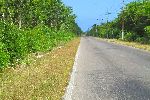
 At
the time of the Revolution this was an extremely poor section of the
country. Severe malnutrition was rampant, illiteracy was the norm, there
were very few roads through the swamps so access to health service was not
timely in an emergency, and the economy was based on a poor fishery and subsistence
agriculture.
At
the time of the Revolution this was an extremely poor section of the
country. Severe malnutrition was rampant, illiteracy was the norm, there
were very few roads through the swamps so access to health service was not
timely in an emergency, and the economy was based on a poor fishery and subsistence
agriculture.
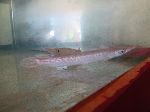
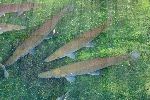 The
fish Atractosteus tristoechus / manjuari / Cuban gar is an endangered specie. It
is one of the most primitive fish specimens still alive today. The recovery
program for the gar includes a captive breeding program, habitat preservation in the form of a
nature preserve, and reduction of predators. The breeding program grows its own food
supply by nurturing vats of highly nutritious green algae. While most of the fish are
release at 1 year olds, some are retained as breeding stock. Life expectancy
for the gar is 35 years. One reason that the fish is endangered is because
the young are prey to the largemouth bass, which was introduced to Cuba,
from Africa, as a
source of protein during the Speical Period (1990-96). Such is the law of
unintended consequence.
The
fish Atractosteus tristoechus / manjuari / Cuban gar is an endangered specie. It
is one of the most primitive fish specimens still alive today. The recovery
program for the gar includes a captive breeding program, habitat preservation in the form of a
nature preserve, and reduction of predators. The breeding program grows its own food
supply by nurturing vats of highly nutritious green algae. While most of the fish are
release at 1 year olds, some are retained as breeding stock. Life expectancy
for the gar is 35 years. One reason that the fish is endangered is because
the young are prey to the largemouth bass, which was introduced to Cuba,
from Africa, as a
source of protein during the Speical Period (1990-96). Such is the law of
unintended consequence.



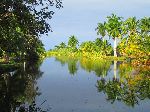

 At
a Cuban crocodile breeding program there is information on the endangered
Cuban crocodile. An exhibit demonstrates that it is much smaller than the American crocodile and manatee
(photos left and right).
Other exhibits at the crocodile farm showing threats, habitat, breeding program,
rearing/feeding, release (5yrs), life expectancy (50yrs) and program
management. It is possible to tour the farm, peer into the age segregated
breeding pens, and pet a muzzled crocodile.
At
a Cuban crocodile breeding program there is information on the endangered
Cuban crocodile. An exhibit demonstrates that it is much smaller than the American crocodile and manatee
(photos left and right).
Other exhibits at the crocodile farm showing threats, habitat, breeding program,
rearing/feeding, release (5yrs), life expectancy (50yrs) and program
management. It is possible to tour the farm, peer into the age segregated
breeding pens, and pet a muzzled crocodile.
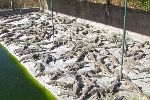




 There
are two small signs outside a UEB associated fish company: One is a sign for the
business and the other defines revolution:
There
are two small signs outside a UEB associated fish company: One is a sign for the
business and the other defines revolution:
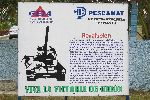 Revolution
is a sense of the historical moment: Is to change everything
that must be changed; It is full equality and liberty;
Is to be treated and treat others as human beings;
Is to emancipate ourselves by ourselves and with our own efforts;
Is to challenge powerful dominant forces within and outside the social and
national sphere; Is to defend values in which one believes at the
price of any sacrifice; Is modesty, disinterestedness,
altruism, solidarity and heroism; Is to fight with audacity, intelligence and
realism; Is not to ever lie or violate ethical principles; It is a
profound conviction that there is no force in the world capable of crushing the
force of truth and ideas. Revolution is unity, it is independence,
it is to fight for our dreams of justice for Cuba and for the world, which is
the basis of our patriotism, our Socialism and our internationalism. LIVE THE
VICTORY OF GIRON.
Revolution
is a sense of the historical moment: Is to change everything
that must be changed; It is full equality and liberty;
Is to be treated and treat others as human beings;
Is to emancipate ourselves by ourselves and with our own efforts;
Is to challenge powerful dominant forces within and outside the social and
national sphere; Is to defend values in which one believes at the
price of any sacrifice; Is modesty, disinterestedness,
altruism, solidarity and heroism; Is to fight with audacity, intelligence and
realism; Is not to ever lie or violate ethical principles; It is a
profound conviction that there is no force in the world capable of crushing the
force of truth and ideas. Revolution is unity, it is independence,
it is to fight for our dreams of justice for Cuba and for the world, which is
the basis of our patriotism, our Socialism and our internationalism. LIVE THE
VICTORY OF GIRON.
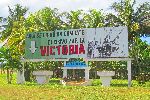
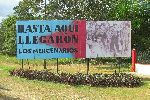

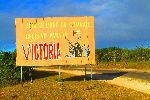
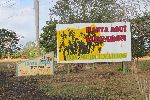

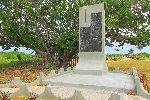
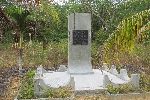 More
subdued monuments along the road marked the location where the defenders of
Cuba fell. The layout of each memorial was the same; a square cement pad,
with landscaping around it and royal palms at the back corners. In the
center is a vertical monument, with a slit replicating a gun sight. One the
monument is a plaque for the fighter(s) that fell there. Many monuments had
just one name, but some had a half dozen or several times that many.
More
subdued monuments along the road marked the location where the defenders of
Cuba fell. The layout of each memorial was the same; a square cement pad,
with landscaping around it and royal palms at the back corners. In the
center is a vertical monument, with a slit replicating a gun sight. One the
monument is a plaque for the fighter(s) that fell there. Many monuments had
just one name, but some had a half dozen or several times that many. 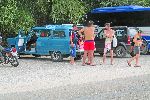
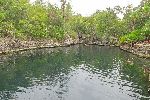
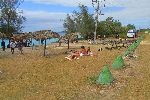 It
is a fair conclusion that they tourists mostly ignore this detail of the
landscape. In this area the biggest attraction is the offshore reef, that makes
a good destination for snorkeling and SCUBA.
It
is a fair conclusion that they tourists mostly ignore this detail of the
landscape. In this area the biggest attraction is the offshore reef, that makes
a good destination for snorkeling and SCUBA.Some are content with lounging on the beach or taking a dip in a swimming hole that has formed in the limestone.


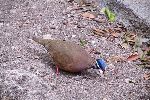 A
couple of patches of cotton along the side of the road are a bit of a curiosity.
If they hadn't been bolting, they wouldn't have been noticed. There wasn't
enough to seem to have a commercial purpose, and no one seem to be picking it.
Wild cotton is found in the tropics around the world, and Mexico has the
greatest diversity of wild cotton species, so that might be the story.
A
couple of patches of cotton along the side of the road are a bit of a curiosity.
If they hadn't been bolting, they wouldn't have been noticed. There wasn't
enough to seem to have a commercial purpose, and no one seem to be picking it.
Wild cotton is found in the tropics around the world, and Mexico has the
greatest diversity of wild cotton species, so that might be the story.Of the birds that were big enough to be easily identifiable, there were some blue headed quail dove and turkey vultures.
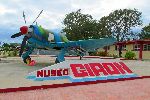
 At the Playa Giron (Bay of Pigs) there is a museum dedicated to the battle. It present the battle from the Cuban government’s perspective. It
covers the Planning, participants, decoys,
and failures of the invasion. There are maps
with the chronology of the troop movements
during the several days of battle. A
lot of real estate is used to detail the CIA sponsored air attacks
leading up to the invasion (or `La Victoria’).
They bombed airfields, strafed air defense systems right in Havana, and
Cuban expatriate operatives torched a department store in the capital. Here, for the first time in Cuban history, a foreign
sponsored invasion was turned back.
One thing that was repeated several times in the museum’s exhibit
was that it was mostly Cuban mercenary
who were captured.
At the Playa Giron (Bay of Pigs) there is a museum dedicated to the battle. It present the battle from the Cuban government’s perspective. It
covers the Planning, participants, decoys,
and failures of the invasion. There are maps
with the chronology of the troop movements
during the several days of battle. A
lot of real estate is used to detail the CIA sponsored air attacks
leading up to the invasion (or `La Victoria’).
They bombed airfields, strafed air defense systems right in Havana, and
Cuban expatriate operatives torched a department store in the capital. Here, for the first time in Cuban history, a foreign
sponsored invasion was turned back.
One thing that was repeated several times in the museum’s exhibit
was that it was mostly Cuban mercenary
who were captured. Interesting
pieces of the story are: President Kennedy was very uneasy with the
CIA-sponsored idea, but wasn't powerful enough to derail it. He
later denied
expected air support to the invading Cuban expatriates as they tried to
establish a beachheads and move inland. Add to this the exiles
misjudged attitude of local
civilians who they expected to support them and give them cover -- the did
neither. Further more the invaders chose a tough coastline for their
landing, and picked a location relatively close to Havana and a
concentration military personnel and assets.
Interesting
pieces of the story are: President Kennedy was very uneasy with the
CIA-sponsored idea, but wasn't powerful enough to derail it. He
later denied
expected air support to the invading Cuban expatriates as they tried to
establish a beachheads and move inland. Add to this the exiles
misjudged attitude of local
civilians who they expected to support them and give them cover -- the did
neither. Further more the invaders chose a tough coastline for their
landing, and picked a location relatively close to Havana and a
concentration military personnel and assets.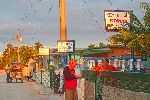
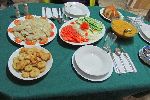
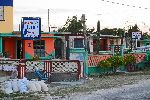 The
next invasion of Yankees (and Asians and Europeans) is invited: Along the main street
of Playa Giron, almost every
other house is advertising rooms for rent to tourists. On the the back street
the density is a little less -- about one out of five house advertises a
rental room. We were told that in high season they can have full occupancy.
The
next invasion of Yankees (and Asians and Europeans) is invited: Along the main street
of Playa Giron, almost every
other house is advertising rooms for rent to tourists. On the the back street
the density is a little less -- about one out of five house advertises a
rental room. We were told that in high season they can have full occupancy.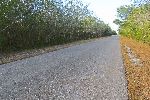
 The road out of the east side of Playa Giron runs
through more flat, wetland forest for a while and then emerges into sugarcane,
rice and agricultural country.
The road out of the east side of Playa Giron runs
through more flat, wetland forest for a while and then emerges into sugarcane,
rice and agricultural country.There are occasional settlements, and in one of these we stopped to visit the school.
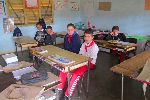


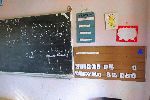
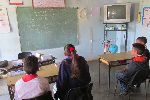


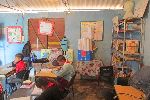
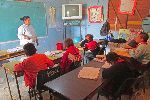

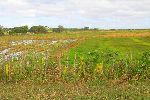

 Rice
is a major crop in this area. The production seems to approach industrial
agriculture - the fields are prepared with tractors, and the rice is cut with
very expensive harvesting combines.
Rice
is a major crop in this area. The production seems to approach industrial
agriculture - the fields are prepared with tractors, and the rice is cut with
very expensive harvesting combines.On the other hand, the drying is decidedly low-tech.

 Drying
rice on roads is not new in the world. It is being done in Africa, Asia and
South America. But it is usually employees abandoned sections of roads or very
low volume roads. This road doesn't meet either criteria, and has large
tourism buses flying through town every few minutes during the morning. A
lot of the grain is scattered, and crop-loss must be substantial. It is
surprising that the same method is still being used.
Drying
rice on roads is not new in the world. It is being done in Africa, Asia and
South America. But it is usually employees abandoned sections of roads or very
low volume roads. This road doesn't meet either criteria, and has large
tourism buses flying through town every few minutes during the morning. A
lot of the grain is scattered, and crop-loss must be substantial. It is
surprising that the same method is still being used.
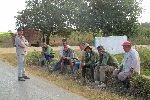 Note from the road:
Note from the road:Even small towns, like Babiney Prieto, have organic farms. (left)
People wait along the road at junctions (right). This was likely to be coming from or going to work.
 Some
place in every town, village and hamlet is a CDR (Committee for the Defense
of the Revolutions) sign. Sometimes they are a large cement monument
(right), or they might be a wood sign, or even just a long, thin, narrow
board, but the CDR is there and can be found.
Some
place in every town, village and hamlet is a CDR (Committee for the Defense
of the Revolutions) sign. Sometimes they are a large cement monument
(right), or they might be a wood sign, or even just a long, thin, narrow
board, but the CDR is there and can be found.CDR we set up after the Revolution in every communities, and in cities on almost every block to communicate and enforce policies from the top, in theory, to communicate the thought of the people to the leaders. In general, the CDR's power and intrusiveness has soften over time.


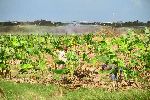
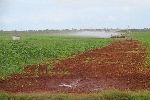



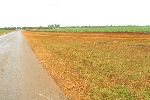




 The
center of this agricultural region is the farm town of Horquitas. Almost
everything about this town says "agriculture." If people are coming into town by
tractor, their transportation power is horse. The art on the wall is
agricultural themed.
The
center of this agricultural region is the farm town of Horquitas. Almost
everything about this town says "agriculture." If people are coming into town by
tractor, their transportation power is horse. The art on the wall is
agricultural themed.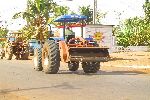





 This
easy-going gentleman is a dairy farmer. As we understand his explanations,
beyond providing a fixed amount of his milk production to the state (a milk tax)
he is free to do what he would like with the rest of the output. He seemed to be
comfortable with the relationship. The arrangement seems to be working well for
him. His cloths were spotless, sturdy and distinguished.
This
easy-going gentleman is a dairy farmer. As we understand his explanations,
beyond providing a fixed amount of his milk production to the state (a milk tax)
he is free to do what he would like with the rest of the output. He seemed to be
comfortable with the relationship. The arrangement seems to be working well for
him. His cloths were spotless, sturdy and distinguished.

 Though
the area is flat and the main roads are in very good condition, there is not a
lot of local bicycle traffic (left) - there is not much traffic of any kind. But
we weren't the only cyclists on the road. We crossed paths a couple times with
this duo who were out for a training ride. It is worth noting that the energy
food of choice is ice cream (right). A local ice cream cone costs less than the
equivalent of a US dollar.
Though
the area is flat and the main roads are in very good condition, there is not a
lot of local bicycle traffic (left) - there is not much traffic of any kind. But
we weren't the only cyclists on the road. We crossed paths a couple times with
this duo who were out for a training ride. It is worth noting that the energy
food of choice is ice cream (right). A local ice cream cone costs less than the
equivalent of a US dollar.

 The
next section of road is from Horquitas to
Yaguaramas. It too had its little gifts to notice and note: For a kilometer
on the outskirts of Horquitas the road is lined with royal palms. Each year
the corridor gets more and more regal. Then, there is a section of trees
that are covered in pink flowers. Not as frou-frou as cherry blooms, but a
picture worthy corridor non the less - even if the camera doesn't capture
their subtlety.
The
next section of road is from Horquitas to
Yaguaramas. It too had its little gifts to notice and note: For a kilometer
on the outskirts of Horquitas the road is lined with royal palms. Each year
the corridor gets more and more regal. Then, there is a section of trees
that are covered in pink flowers. Not as frou-frou as cherry blooms, but a
picture worthy corridor non the less - even if the camera doesn't capture
their subtlety. 
 In
another grove of trees is a memorial to the tenacious hero and US citizen, Henry
Reeve (1850 - 1876). Though he fought slavery in the US and Cuba, in the
twist of politics, it is the Cubans, not the USA, that keep his memory alive.
In
another grove of trees is a memorial to the tenacious hero and US citizen, Henry
Reeve (1850 - 1876). Though he fought slavery in the US and Cuba, in the
twist of politics, it is the Cubans, not the USA, that keep his memory alive.In his early years, Reeve was a drummer in the Union Army, during the American Civil War. He arrived in Cuba in 1869 aboard the vessel Perrit as part of an Expeditionary Force. The expedition was ambushed by the Spanish Army while unloading and Reeve was taken prisoner, along with many others. A Spanish firing squad shot the group, and left them unburied and presumed dead. Reeve was wounded but had enough strength to creep away, and was found by units of the Cuban Army. In one critical action, he leaped over an artillery battery, lifting the morale of the Cuban fighters, but sustained a serious leg wound. He was told he would never walk or ride a horse again. Reeve persevered and with metallic braces he was able to walk, but had to be strapped to his mount in order to be able to ride his horse. He eventually achieved the rank of a Brigadier General in Cuba's 'Ejército Libertador' (Army of Liberation) - more commonly known as the 'Ejército Mambí' - during the First Cuban War of Independence (Ten Years' War) (1868-1878). He kept leading the famed Camagüey Cavalry Corps throughout the balance of his life. Under Máximo Gómez' command Reeve participated in the failed invasion of Western Cuba. Stranded in the province of Matanzas in 1876, the Spanish annihilated his small escort at Yaguaramas; unable to ride, Reeve shot himself with his handgun before being captured. Reeve was 26 years old at the time of his death, and had served in the Cuban Army for 7 years, having participated in over 400 engagements against the Spanish Army. The memorial is near the site of his death.
In response to Hurricane Katrina, Cuba assembled 1,586 humanitarian doctors to offer to assist the United States. The offer was declined, and on September 19, 2005 Fidel Castro created the Henry Reeve International Contingent of Doctors Specialized in Disasters and Serious Epidemics in honor of him.
On January 31, 2017, the World Health Organization (WHO) awarded its Prize for Public Health to Cuba’s Henry Reeve Contingent, in recognition of its international solidarity efforts combating natural disasters and serious epidemics. 7,254 Cuban medical collaborators have offered services in 19 nations worldwide.

 The
poetry of these pictures are the cows, cowboys, horses and dogs. You often see
the four traveling together. The dogs are the greatest. They will run up and
gently keep the cows disciplined as needed, and then when their efforts are not
needed, they will unassumingly retreat to behind the horse, shirking any
limelight. The farm dogs of Cuba, when they aren't sleeping, always seem to
ready to work and are always faithful.
The
poetry of these pictures are the cows, cowboys, horses and dogs. You often see
the four traveling together. The dogs are the greatest. They will run up and
gently keep the cows disciplined as needed, and then when their efforts are not
needed, they will unassumingly retreat to behind the horse, shirking any
limelight. The farm dogs of Cuba, when they aren't sleeping, always seem to
ready to work and are always faithful.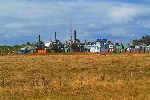
 Yaguaramas
is roughly the same size as Horquitas, is closer to main roads, and it has a
large diesel power plant (left), but it has much less character, or main
street economic activity. Very little to see here, so it is time to move on.
Yaguaramas
is roughly the same size as Horquitas, is closer to main roads, and it has a
large diesel power plant (left), but it has much less character, or main
street economic activity. Very little to see here, so it is time to move on.
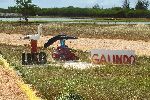
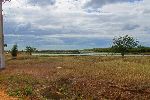 Outside
of Yaguaramas is a UEB catfish fish farm (left).
Outside
of Yaguaramas is a UEB catfish fish farm (left).Their message sign (right) says, "Do your share of duty, and nothing can defeat us." -José Marti



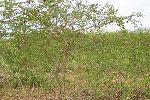 To
the east of Yaguaramas, there is a section that is primarily acacia. It is an
exotic specie that has taken over. It has the positive quality of being a
nitrogen fixer, but in the Cuban economy, cattle grazing is the only use that
can share the land.
To
the east of Yaguaramas, there is a section that is primarily acacia. It is an
exotic specie that has taken over. It has the positive quality of being a
nitrogen fixer, but in the Cuban economy, cattle grazing is the only use that
can share the land. We stopped for lunch at a small roadside cafe
where the overwhelmed family served many ravenous cyclists beans and rice,
and made small pizzas as fast as they could.
After lunch we crossed another sizable swamp that appeared
connected to marine waters. The
road causeway ran right through it, preventing water circulation.
Half the swamp was slowly being destroyed. Back in sugarcane fields again.
A harvester made a turn just as we past and shot sugarcane leaves
and debris across the road, just about hitting us.
We passed two men in horse-drawn cart stopped at a bridge.
Caught in a stiff headwind, we heard the clip-clop of hooves behind
us. Soon, they passed
us, waving and enjoying the sport. They
turned off the road a little ways up.
We stopped for lunch at a small roadside cafe
where the overwhelmed family served many ravenous cyclists beans and rice,
and made small pizzas as fast as they could.
After lunch we crossed another sizable swamp that appeared
connected to marine waters. The
road causeway ran right through it, preventing water circulation.
Half the swamp was slowly being destroyed. Back in sugarcane fields again.
A harvester made a turn just as we past and shot sugarcane leaves
and debris across the road, just about hitting us.
We passed two men in horse-drawn cart stopped at a bridge.
Caught in a stiff headwind, we heard the clip-clop of hooves behind
us. Soon, they passed
us, waving and enjoying the sport. They
turned off the road a little ways up.



![]() Please write if you have questions, comment, criticism, praise or
additional information for us, find a bad link or would like to be added to IBF's mailing list. (Also let
us know how you found this site.)
Please write if you have questions, comment, criticism, praise or
additional information for us, find a bad link or would like to be added to IBF's mailing list. (Also let
us know how you found this site.)
![]() IBF Homepage
IBF Homepage
![]() Cuba
Homepage
Cuba
Homepage ![]() Search
ibike
Search
ibike
"Hosted by
DreamHost - earth friendly web hosting"
Created by David Mozer.
Copyright © 1995-2021 International Bicycle Fund. All rights reserved.